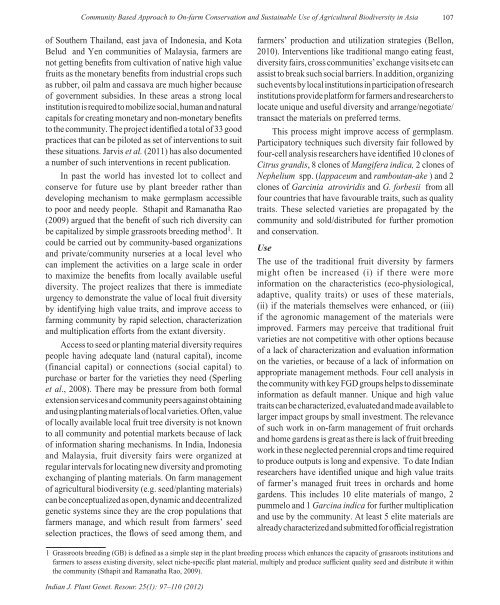indian society of plant genetic resources - Bioversity International
indian society of plant genetic resources - Bioversity International
indian society of plant genetic resources - Bioversity International
You also want an ePaper? Increase the reach of your titles
YUMPU automatically turns print PDFs into web optimized ePapers that Google loves.
Community Based Approach to On-farm Conservation and Sustainable Use <strong>of</strong> Agricultural Biodiversity in Asia 107<br />
<strong>of</strong> Southern Thailand, east java <strong>of</strong> Indonesia, and Kota<br />
Belud and Yen communities <strong>of</strong> Malaysia, farmers are<br />
not getting benefi ts from cultivation <strong>of</strong> native high value<br />
fruits as the monetary benefi ts from industrial crops such<br />
as rubber, oil palm and cassava are much higher because<br />
<strong>of</strong> government subsidies. In these areas a strong local<br />
institution is required to mobilize social, human and natural<br />
capitals for creating monetary and non-monetary benefi ts<br />
to the community. The project identifi ed a total <strong>of</strong> 33 good<br />
practices that can be piloted as set <strong>of</strong> interventions to suit<br />
these situations. Jarvis et al. (2011) has also documented<br />
a number <strong>of</strong> such interventions in recent publication.<br />
In past the world has invested lot to collect and<br />
conserve for future use by <strong>plant</strong> breeder rather than<br />
developing mechanism to make germplasm accessible<br />
to poor and needy people. Sthapit and Ramanatha Rao<br />
(2009) argued that the benefi t <strong>of</strong> such rich diversity can<br />
be capitalized by simple grassroots breeding method1 . It<br />
could be carried out by community-based organizations<br />
and private/community nurseries at a local level who<br />
can implement the activities on a large scale in order<br />
to maximize the benefi ts from locally available useful<br />
diversity. The project realizes that there is immediate<br />
urgency to demonstrate the value <strong>of</strong> local fruit diversity<br />
by identifying high value traits, and improve access to<br />
farming community by rapid selection, characterization<br />
and multiplication efforts from the extant diversity.<br />
Access to seed or <strong>plant</strong>ing material diversity requires<br />
people having adequate land (natural capital), income<br />
(financial capital) or connections (social capital) to<br />
purchase or barter for the varieties they need (Sperling<br />
et al., 2008). There may be pressure from both formal<br />
extension services and community peers against obtaining<br />
and using <strong>plant</strong>ing materials <strong>of</strong> local varieties. Often, value<br />
<strong>of</strong> locally available local fruit tree diversity is not known<br />
to all community and potential markets because <strong>of</strong> lack<br />
<strong>of</strong> information sharing mechanisms. In India, Indonesia<br />
and Malaysia, fruit diversity fairs were organized at<br />
regular intervals for locating new diversity and promoting<br />
exchanging <strong>of</strong> <strong>plant</strong>ing materials. On farm management<br />
<strong>of</strong> agricultural biodiversity (e.g. seed/<strong>plant</strong>ing materials)<br />
can be conceptualized as open, dynamic and decentralized<br />
<strong>genetic</strong> systems since they are the crop populations that<br />
farmers manage, and which result from farmers’ seed<br />
selection practices, the fl ows <strong>of</strong> seed among them, and<br />
Indian J. Plant Genet. Resour. 25(1): 97–110 (2012)<br />
farmers’ production and utilization strategies (Bellon,<br />
2010). Interventions like traditional mango eating feast,<br />
diversity fairs, cross communities’ exchange visits etc can<br />
assist to break such social barriers. In addition, organizing<br />
such events by local institutions in participation <strong>of</strong> research<br />
institutions provide platform for farmers and researchers to<br />
locate unique and useful diversity and arrange/negotiate/<br />
transact the materials on preferred terms.<br />
This process might improve access <strong>of</strong> germplasm.<br />
Participatory techniques such diversity fair followed by<br />
four-cell analysis researchers have identifi ed 10 clones <strong>of</strong><br />
Citrus grandis, 8 clones <strong>of</strong> Mangifera indica, 2 clones <strong>of</strong><br />
Nephelium spp. (lappaceum and ramboutan-ake ) and 2<br />
clones <strong>of</strong> Garcinia atroviridis and G. forbesii from all<br />
four countries that have favourable traits, such as quality<br />
traits. These selected varieties are propagated by the<br />
community and sold/distributed for further promotion<br />
and conservation.<br />
Use<br />
The use <strong>of</strong> the traditional fruit diversity by farmers<br />
might <strong>of</strong>ten be increased (i) if there were more<br />
information on the characteristics (eco-physiological,<br />
adaptive, quality traits) or uses <strong>of</strong> these materials,<br />
(ii) if the materials themselves were enhanced, or (iii)<br />
if the agronomic management <strong>of</strong> the materials were<br />
improved. Farmers may perceive that traditional fruit<br />
varieties are not competitive with other options because<br />
<strong>of</strong> a lack <strong>of</strong> characterization and evaluation information<br />
on the varieties, or because <strong>of</strong> a lack <strong>of</strong> information on<br />
appropriate management methods. Four cell analysis in<br />
the community with key FGD groups helps to disseminate<br />
information as default manner. Unique and high value<br />
traits can be characterized, evaluated and made available to<br />
larger impact groups by small investment. The relevance<br />
<strong>of</strong> such work in on-farm management <strong>of</strong> fruit orchards<br />
and home gardens is great as there is lack <strong>of</strong> fruit breeding<br />
work in these neglected perennial crops and time required<br />
to produce outputs is long and expensive. To date Indian<br />
researchers have identifi ed unique and high value traits<br />
<strong>of</strong> farmer’s managed fruit trees in orchards and home<br />
gardens. This includes 10 elite materials <strong>of</strong> mango, 2<br />
pummelo and 1 Garcina indica for further multiplication<br />
and use by the community. At least 5 elite materials are<br />
already characterized and submitted for <strong>of</strong>fi cial registration<br />
1 Grassroots breeding (GB) is defi ned as a simple step in the <strong>plant</strong> breeding process which enhances the capacity <strong>of</strong> grassroots institutions and<br />
farmers to assess existing diversity, select niche-specifi c <strong>plant</strong> material, multiply and produce suffi cient quality seed and distribute it within<br />
the community (Sthapit and Ramanatha Rao, 2009).

















